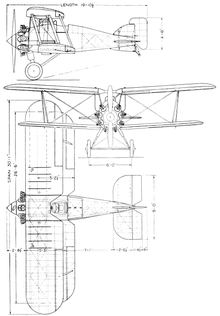
The Gloster Meteor was the first British jet fighter and the Allies' only jet aircraft to engage in combat operations during the Second World War. The Meteor's development was heavily reliant on its ground-breaking turbojet engines, pioneered by Frank Whittle and his company, Power Jets Ltd. Development of the aircraft began in 1940, although work on the engines had been under way since 1936. The Meteor first flew in 1943 and commenced operations on 27 July 1944 with No. 616 Squadron RAF. The Meteor was not a sophisticated aircraft in its aerodynamics, but proved to be a successful combat fighter. Gloster's 1946 civil Meteor F.4 demonstrator G-AIDC was the first civilian-registered jet aircraft in the world. Several major variants of the Meteor incorporated technological advances during the 1940s and 1950s. Thousands of Meteors were built to fly with the RAF and other air forces and remained in use for several decades.

The Gloster Gladiator is a British biplane fighter. It was used by the Royal Air Force (RAF) and the Fleet Air Arm (FAA) and was exported to a number of other air forces during the late 1930s.

The Gloster Javelin is a twin-engined all-weather interceptor aircraft that served with Britain's Royal Air Force from the mid-1950s until the late 1960s. It was a T-tailed delta-wing aircraft designed for night and all-weather operations and was the last aircraft design to bear the Gloster name. Introduced in 1956 after a lengthy development period, the aircraft received several upgrades during production to its engines, radar and weapons, including support for the De Havilland Firestreak air-to-air missile.

The Bristol Bulldog is a British Royal Air Force single-seat biplane fighter designed during the 1920s by the Bristol Aeroplane Company. More than 400 Bulldogs were produced for the RAF and overseas customers, and it was one of the most famous aircraft used by the RAF during the inter-war period.
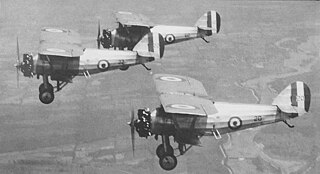
The Armstrong Whitworth Siskin was a sesquiplane single-seat fighter aircraft developed and produced by the British aircraft manufacturer Armstrong Whitworth Aircraft. It was also the first all-metal fighter to be operated by the Royal Air Force (RAF), as well as being one of the first new fighters to enter service following the end of the First World War.

The Boulton Paul P.29 Sidestrand was a twin-engine biplane medium bomber of the Royal Air Force. Designed for daylight operations, it was manoeuvrable and provided with three defensive gun positions. Named after a village on the Norfolk coast near Boulton & Paul's factory in Norwich, the Sidestrand first flew in 1926 and entered service in 1928. It remained in service until 1936, equipping No. 101 Squadron RAF. It was an agile and relatively fast aircraft that was capable of aerobatic manoeuvres such as loops, rolls and spins.
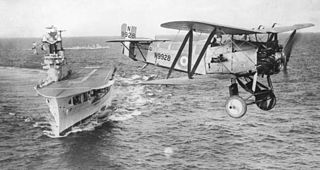
The Fairey Flycatcher was a British single-seat biplane carrier-borne fighter aircraft made by Fairey Aviation Company which served from 1923 to 1934. It was produced with a conventional undercarriage for carrier use, although this could be exchanged for floats for catapult use aboard capital ships.

The Gloster Grebe was developed by the Gloster Aircraft Company from the Gloster Grouse, and was the Royal Air Force's first post-First World War fighter aircraft, entering service in 1923.

The Vickers Vildebeest and the similar Vickers Vincent were two very large two- to three-seat single-engined British biplanes designed and built by Vickers and used as light bombers, torpedo bombers and in army cooperation roles. First flown in 1928, it remained in service at the start of the Second World War, with the last Vildebeests flying against Japanese forces over Singapore and Java in 1942.

The Vickers Type 56 Victoria was a British biplane freighter and troop transport aircraft used by the Royal Air Force. The Victoria flew for the first time in 1922 and was selected for production over the Armstrong Whitworth Awana.

The Vickers Virginia was a biplane heavy bomber of the British Royal Air Force, developed from the Vickers Vimy.

The Hawker Woodcock was a British single-seat fighter built by the Hawker Engineering Company as the first fighter to be produced by Hawker Engineering. It was used by the RAF as a night fighter in the 1920s.

The Gloster Gauntlet was a single-seat biplane fighter designed and produced by the British aeroplane manufacturer Gloster Aircraft in the 1930s. It was the last fighter to be operated by the Royal Air Force (RAF) to have an open cockpit, and also the penultimate biplane fighter in its service.

The Nakajima A1N, or Navy Type 3 Carrier Fighter, was a Japanese carrier-based fighter of the late-1920s and early-1930s. It was a licensed copy of the British Gloster Gambet fighter, built by the Nakajima Aircraft Company for the Imperial Japanese Navy. Approximately 150 were built in two versions, the A1N1 and A1N2.

The Westland Wapiti was a British two-seat general-purpose military single-engined biplane of the 1920s. It was designed and built by Westland Aircraft Works to replace the Airco DH.9A in Royal Air Force service.

The Fairey Hendon was a British monoplane, heavy bomber of the Royal Air Force, designed by Fairey Aviation in the late 1920s. The aircraft served in small numbers with one squadron of the RAF between 1936 and 1939. It was the first all-metal construction low-wing monoplane to enter service with the RAF.

The Boulton Paul Balliol and Sea Balliol are monoplane advanced trainer aircraft designed and produced by the British aircraft manufacturer Boulton Paul Aircraft. On 17 May 1948, it became the world's first single-engined turboprop aircraft to fly. The Balliol was operated primarily by both the Royal Air Force (RAF) and the Royal Navy Fleet Air Arm (FAA).

The Fairey Fawn was a British single-engine light bomber of the 1920s. It was designed as a replacement for the Airco DH.9A and served with the Royal Air Force between 1924 and 1929.
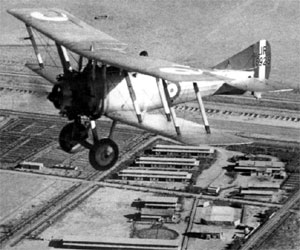
The Nieuport Nighthawk was a British fighter aircraft developed by the Nieuport & General Aircraft company for the Royal Air Force towards the end of the First World War. Although ordered into production before the aircraft first flew, it did not enter large scale service with the RAF owing to unreliable engines. Re-engined aircraft did see service in Greece, serving from 1923 to 1938.
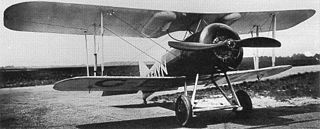
The Gloster Grouse was a British biplane of the 1920s developed by the Gloster Aircraft Company. Often referred to as the prototype to the Gloster Grebe, the Grouse originally built as an experimental aircraft and then later developed as a trainer. Despite its compact design and maneuverability, the Grouse was not in itself a commercial success, although it formed the basis for the Gloster Grebe and Gamecock fighters which were used by Britain's Royal Air Force into the 1930s.




